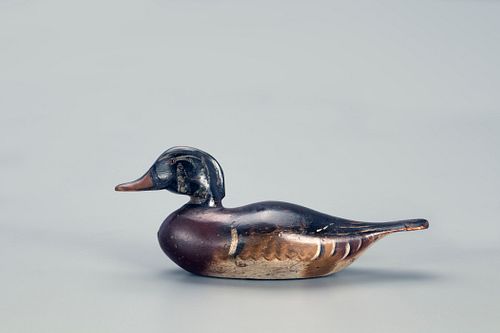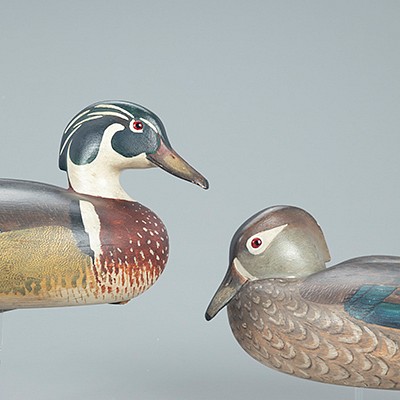The Dodge Wood Duck Decoy, J. N. Dodge Factory (1883-1893)
About Seller
20 Winter Street
Pembroke, MA 02359
United States
Founded in 2005, Copley Fine Art Auctions is a boutique auction house specializing in antique decoys and American, sporting, and wildlife paintings. Over the course of the last two decades, the firm has set auction records for not only individual decoy makers, but also entire carving regions. Copley...Read more
Two ways to bid:
- Leave a max absentee bid and the platform will bid on your behalf up to your maximum bid during the live auction.
- Bid live during the auction and your bids will be submitted real-time to the auctioneer.
Bid Increments
| Price | Bid Increment |
|---|---|
| $0 | $50 |
| $1,000 | $100 |
| $2,500 | $250 |
| $5,000 | $500 |
| $10,000 | $1,000 |
| $25,000 | $2,500 |
| $50,000 | $5,000 |
About Auction
Mar 4, 2022
Lots 1-264 Copley Fine Art Auctions cinnie@copleyart.com
- Lot Description
The Dodge Wood Duck
J. N. Dodge Factory (1883-1893)
Detroit, MI, c. 1885
16 1/4 in. long
"Striking a regal pose, this Dodge drake wood duck is, no doubt, the finest example extant. In fact, it is the only example of this species in original paint known to the authors." — Ron Sharp and Bill Dodge, “Detroit Decoy Dynasty”
This is the only wood duck known to have survived in original paint from the early and esteemed Dodge Factory. Beyond its rarity, this is among the finest wood ducks and factory decoys extant. In the 1981 book “Decoys of the Mississippi Flyway,” decoy historian and author Alan G. Haid sums the bird up, writing: "A classic. The finest example known from the Dodge Factory."
In their book, "Detroit Decoy Dynasty: The Factory Decoys of Petersen, Dodge, and Mason," Ron Sharp and Bill Dodge relate that Jasper Newton Dodge (1829-1909) was a decoy maker in the 1870s who worked alongside William Mason at a gun store in Detroit. In 1881 Mason bought the gun store and most likely hired Dodge to supply the store with decoys. The Dodge Factory’s early run from 1883 to 1893 places its entire production years ahead of the prolific Mason Decoy Factory, which was in operation from 1896 to 1924.
In his catalog, Dodge described his decoys and his process of construction as follows: "All my decoys are made of thoroughly kiln dried White Cedar. No. 1's are made of selected pieces, every one perfect. They are the exact size and shape, and painted to closely imitate the duck they are intended to represent. The heads are made a perfect imitation in every way, each variety having a different shape, according to the shape of the bird. They are attached to the body with a half inch hard maple dowel, well glued in, and cannot be easily broken off or removed. They have the best English Enamelled Glass Eyes, colored exactly the same as the natural bird. All have four coats of the best paint, ground in oil, thoroughly applied, and given plenty of time to dry between the coats. The heads are placed on the bodies turned in different directions, which gives them a very life-like appearance. Being the same shape they ride the water like a duck. They are pronounced by all sportsmen to be the best that are made."
In the caption below the full-page illustration of this carving, the authors of "Detroit Decoy Dynasty” write, "Striking a regal pose, this Dodge drake wood duck is, no doubt, the finest example extant. In fact, it is the only example of this species in original paint known to the authors."
For years this early and exceptional Dodge summer duck resided in the same esteemed collection as the Mason wood duck drake. The Mason, which was made decades later, and was directly inspired by Dodge, sold for $690,000 in 2014, placing it among the top ten decoys ever sold at auction.
The form, paint, rarity, species, literature selections, and critical exaltations of this decoy place it among the most important 19th-century factory waterfowl decoys known.
Excellent original paint with moderate gunning wear. Bill and chip to top of head have been professionally restored. Touch-up to front left corner of neck putty.
Provenance: Private Collection
Literature: Alan G. Haid, “Decoys of the Mississippi Flyway,” Exton, PA, 1981, p. 71, exact decoy illustrated. Russ J. Goldberger and Alan Haid, "Mason Decoys: A Pictorial Guide," “Updated Edition,” Lewes, DE, 2014, p. 158, exact decoy illustrated. Guyette and Schmidt, "North American Decoys at Auction, April 25 & 26, 2002," St. Charles, IL, front cover and lot 651, exact decoy illustrated. Ron Sharp and Bill Dodge, “Detroit Decoy Dynasty: The Factory Decoys of Petersen, Dodge, and Mason,” Lawsonville, NC, 2009, p. 146, exact decoy illustrated. “The Call of the Wild,” The Dixon Gallery and Garden Exhibition Catalog, January 2007, p. 91, exact carving illustrated. Exhibited: Memphis, Tennessee, “The Call of the Wild,” The Dixon Gallery and Garden, November 12, 2006–January 7, 2007Please email condition report requests to colin@copleyart.com. Any condition statement given is a courtesy to customers, Copley will not be held responsible for any errors or omissions. The absence of a condition statement does not imply that the lot is in perfect condition.Condition
- Shipping Info
-
Copley Fine Art Auctions does not handle the shipping of any items. Shipping is the sole responsibility of the buyer. Once your payment has cleared, and we have received your authorized shipping release form items may be released for shipment. Copley Fine Art Auctions, LLC shall have no liability for any loss or damage to such items. Buyers should allow up to four weeks for shipment.
-



 EUR
EUR CAD
CAD AUD
AUD GBP
GBP MXN
MXN HKD
HKD CNY
CNY MYR
MYR SEK
SEK SGD
SGD CHF
CHF THB
THB

















